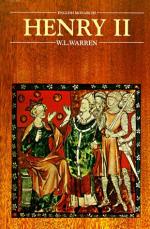set foot in Ireland. The short winter’s
work was to end in utter confusion. The king’s
policy had been to set up the royal justice and power,
and to break the strength of the barons by dividing
and curtailing their interests. He had left them
without a leader. The growing power of Strongbow
had been broken; Dublin had been taken from him; the
castles had all been committed to knights appointed
by the king. Quarrels and rivalries soon broke
out. Raymond the Fat became the recognized head
of Nesta’s descendants. In his enormous
frame, his yellow curly hair, his high-coloured cheery
face, his large gray eyes, we seethe type of the old
Norse conquerors who had once harried England; we
recognize it too in his carelessness as to food or
clothing, his indifference to hardship, his prodigious
energy, the sleepless nights spent in wandering through
his camp where his resounding shouts awoke the sleeping
sentinels, the enduring wrath which never forgot an
enemy. Richard’s uncle, Hervey of Mount
Moriss, led a rival faction in the interests of Strongbow.
The English garrison in Ireland was weakened by the
loss of troops which Henry was compelled to carry away
with him. The forces that remained, divided,
thinned, discouraged, were left to confront an Irish
party united in a revived hope. No sooner did
rebellion break over England in the next year than
the Irish with one accord rose in revolt. The
treasury was exhausted, and there was no payment for
the troops. A doubtful campaign went on in which
the English, attacked now by the Ostmen of the towns,
now by the Irish, fought with very varying success,
but with prodigies of valour. They were reckless
of danger, heedless of the common safeguards of military
precaution. When Henry heard of Raymond’s
daring capture of Limerick in 1176, and then of his
retreat, he made one of his pithy “Great was
the courage in attacking it, and yet greater in the
subduing of it, but the only wisdom that was shown
was in its desertion.”
The rivalry of Raymond and Strongbow was at its height
when, in 1176, Earl Richard died; and to this day
his burial-place in the Norman Cathedral in Dublin,
and that of his wife Aeifi, are marked by the only
sculptured tombs that exist of these first Norman conquerors
of Ireland. Others besides the king heard with
joy the news that the great warrior was dead.
Richard’s sister, who had been married to Raymond,
had cast in her lot with her lord. She sent a
cautious despatch to her husband, who was unable himself
to read, and had to depend on the good offices of a
clerk. “Know, my dearest lord,” wrote
the prudent wife, “that that great tooth which
pained me so long has now fallen out, wherefore see
that you delay not your return.” The watchful
Henry, however, at once recalled Raymond to England,
and sent a new governor, Fitz-Aldhelm, to hold the
restless barons in check, till his son John, to whom
he now proposed to give the realm of Ireland, should
be of age to undertake its government. When Fitz-Aldhelm




